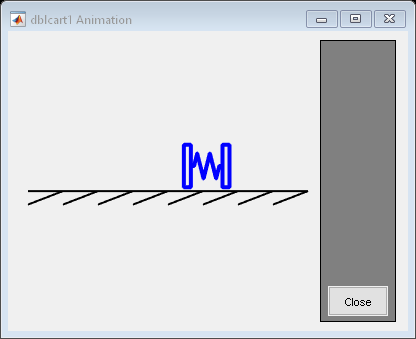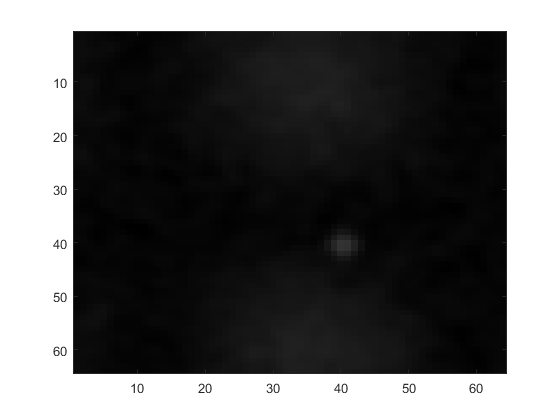State-Space
Implement linear state-space system
Libraries:
Simulink /
Continuous
Description
The State-Space block implements a system whose behavior you define as
where x is the state vector, u is the input vector, y is the output vector, and x0 is the initial condition of the state vector. The A, B, C, and D matrices can be specified as either sparse matrices or dense matrices. The matrix coefficients must have these characteristics:
A must be an n-by-n matrix, where n is the number of states.
B must be an n-by-m matrix, where m is the number of inputs.
C must be an r-by-n matrix, where r is the number of outputs.
D must be an r-by-m matrix.

In general, the block has one input port and one output port. The number of rows in C or D matrix is the same as the width of the output port. The number of columns in the B or D matrix are the same as the width of the input port. If you want to model an autonomous linear system with no inputs, set the B and D matrices to empty. In this case, the block acts as a source block with no input port and one output port, and implements the following system:
Simulink® software converts a matrix containing zeros to a sparse matrix for efficient multiplication.
Examples
Ports
Input
Port_1 — Input signal
scalar | vector
Real-valued input vector of type double, where the
width equals the number of columns in the B and
D matrices. For more information, see Description.
Data Types: double
Output
Port_1 — Output vector
scalar | vector
Real-valued output vector of data type double, with
width equal to the number of rows in the C and
D matrices. For more information, see Description.
Data Types: double
Parameters
A — Matrix coefficient, A
1 (default) | scalar | vector | matrix | sparse matrix
Specify the matrix coefficient A, as a real-valued
n-by-n matrix, where
n is the number of states. For more information on
the matrix coefficients, see Description.
Programmatic Use
Block Parameter:
A |
| Type: character vector, string |
| Values: scalar | vector | matrix | sparse matrix |
Default:
'1' |
B — Matrix coefficient, B
1 (default) | scalar | vector | matrix | sparse matrix
Specify the matrix coefficient B, as a real-valued
n-by-m matrix, where
n is the number of states and m is
the number of inputs. For more information on the matrix coefficients, see
Description.
Programmatic Use
Block Parameter:
B |
| Type: character vector, string |
| Values: scalar | vector | matrix | sparse matrix |
Default:
'1' |
C — Matrix coefficient, C
1 (default) | scalar | vector | matrix | sparse matrix
Specify the matrix coefficient C as a real-valued r-by-n matrix, where r is the number of outputs and n is the number of states. For more information on the matrix coefficients, see Description.
Programmatic Use
Block Parameter:
C |
| Type: character vector, string |
| Values: scalar | vector | matrix | sparse matrix |
Default:
'1' |
D — Matrix coefficient, D
1 (default) | scalar | vector | matrix | sparse matrix
Specify the matrix coefficient D as a real-valued r-by-m matrix, where r is the number of outputs and m is the number of inputs. For more information on the matrix coefficients, see Description.
Programmatic Use
Block Parameter:
D |
| Type: character vector, string |
| Values: scalar | vector | matrix | sparse matrix |
Default:
'1' |
Initial conditions — Initial state vector
0 (default) | scalar | vector
Specify the initial state vector.
Limitations
The initial conditions of this block cannot be inf
or NaN.
Programmatic Use
Block Parameter:
X0
|
| Type: character vector, string |
| Values: scalar | vector |
Default:
'0' |
Parameter tunability — Choose tunable representation of block parameters
Auto (default) | Optimized | Unconstrained
Tunability level of the state-space matrices (A,B,C, and D ) for accelerated simulation
modes and deployed simulations using the Simulink
Compiler™. When set to Auto, Simulink chooses the appropriate parameter tunability level.
For sparse matrix coefficients, set the parameter to
Optimized to allow tunability of non-zero
elements while keeping the pattern and number of non-zero elements constant.
Set this parameter to Unconstrained to allow all
elements to be tunable, so long as the number of non-zero elements is kept
constant, that is, you can change the pattern of the sparse matrix.
For dense matrix coefficients, select Optimized to allow
tunability of all matrix elements, provided the number of non-zero elements
initially specified in the matrix is kept constant. Set this parameter to
Unconstrained to allow full tunability of all
matrix elements.
Note
To tune the D matrix of the block when D = 0, you must enable the Allow non-zero values for D matrix initially specified as zero parameter.
Programmatic Use
Block Parameter:
ParameterTunability
|
| Type: character vector | string |
Values:
'Auto' | 'Optimized' |
'Unconstrained' |
Default:
'Auto' |
Allow non-zero values for D matrix initially specified as zero — Allow tunability of D matrix when D = 0
off (default) | on
Enable this parameter to support tunability of D even when D = 0.
Note
Enabling this parameter enables direct feedthrough for the State-Space block.
Programmatic Use
Block Parameter:
AllowTunableDMatrix
|
| Type: character vector | string |
Values:
'off' | 'on' |
Default:
'off' |
Absolute tolerance — Absolute tolerance for computing block states
auto (default) | scalar | vector
Variable-step solvers use absolute and relative tolerances when choosing the step size to determine whether the error in state calculations is acceptable.
To inherit the absolute tolerance from the Absolute tolerance configuration parameter, specify this parameter
value as auto or -1.
To specify an absolute tolerance for this block that overrides the value specified for the Absolute tolerance configuration parameter:
Enter a real, positive scalar value to use to compute all block states.
Enter a real vector with dimensions that match the dimensions of the continuous states for the block.
Programmatic Use
Block Parameter: AbsoluteTolerance |
| Type: string | character vector |
Values:
'auto' | '-1' | positive, real scalar |
vector of positive, real scalars |
Default: 'auto' |
State Name (e.g., 'position') — Option to assign unique names to states
' ' (default) | character vector | cell array of character vectors | MATLAB® variable | ...
Use this parameter to optionally assign names to the states of this block. The names you assign apply only to the states of this block.
To use default state names, leave this field blank (
'').To assign a single name to a single state, enter the name between quotes. For example, to name a single state
position, enter"position".To assign names to multiple states, specify this parameter value as a cell array of character vectors. Each name in the cell array must be unique. For example, to assign the names
a,b, andc, enter{'a','b','c'}.To specify the names using a MATLAB variable, enter the name of the variable without quotes. For example, to use the variable
namesto specify the state names, enternames.
You can specify a number of names that is less than the number of states in the block. In this case, the state names are used for multiple states, and the number of states must divide evenly into the number of state names. For example, when you specify two names for a block that has four states, the first name is used for the first two states, and the second name is used for the last two states.
Programmatic Use
Block Parameter:
ContinuousStateAttributes |
| Type: string | character vector |
Values:
' ' | user-defined |
Default:
' ' |
Block Characteristics
Data Types |
|
Direct Feedthrough |
|
Multidimensional Signals |
|
Variable-Size Signals |
|
Zero-Crossing Detection |
|
Extended Capabilities
C/C++ Code Generation
Generate C and C++ code using Simulink® Coder™.
Not recommended for production-quality code. Relates to resource limits and restrictions on speed and memory often found in embedded systems. The code generated can contain dynamic allocation and freeing of memory, recursion, additional memory overhead, and widely-varying execution times. While the code is functionally valid and generally acceptable in resource-rich environments, smaller embedded targets often cannot support such code.
In general, consider using the Simulink Model Discretizer to map continuous blocks into discrete equivalents that support production code generation. To start the Model Discretizer, in the Simulink Editor, on the Apps tab, under Apps, under Control Systems, click Model Discretizer. One exception is the Second-Order Integrator block because, for this block, the Model Discretizer produces an approximate discretization.
Version History
Introduced before R2006a
MATLAB Command
You clicked a link that corresponds to this MATLAB command:
Run the command by entering it in the MATLAB Command Window. Web browsers do not support MATLAB commands.

Select a Web Site
Choose a web site to get translated content where available and see local events and offers. Based on your location, we recommend that you select: .
You can also select a web site from the following list:
How to Get Best Site Performance
Select the China site (in Chinese or English) for best site performance. Other MathWorks country sites are not optimized for visits from your location.
Americas
- América Latina (Español)
- Canada (English)
- United States (English)
Europe
- Belgium (English)
- Denmark (English)
- Deutschland (Deutsch)
- España (Español)
- Finland (English)
- France (Français)
- Ireland (English)
- Italia (Italiano)
- Luxembourg (English)
- Netherlands (English)
- Norway (English)
- Österreich (Deutsch)
- Portugal (English)
- Sweden (English)
- Switzerland
- United Kingdom (English)

